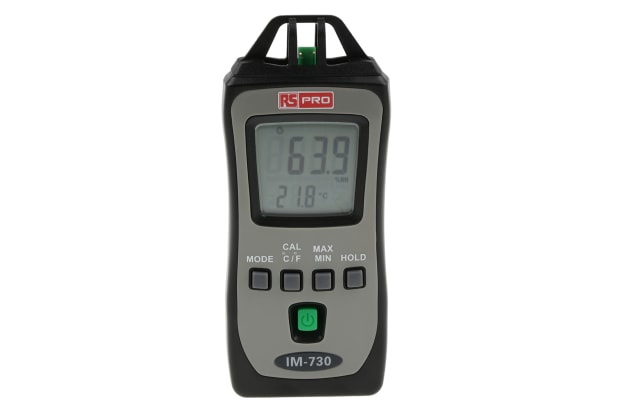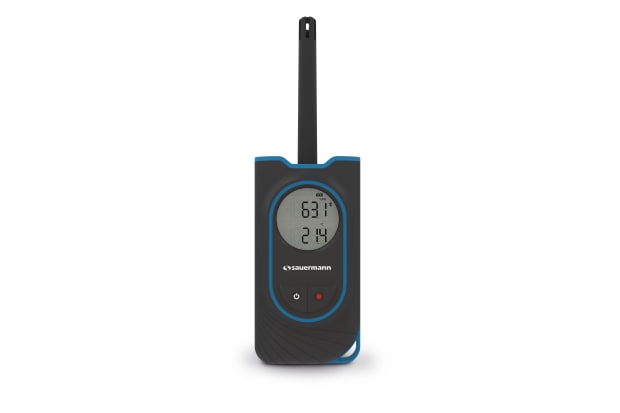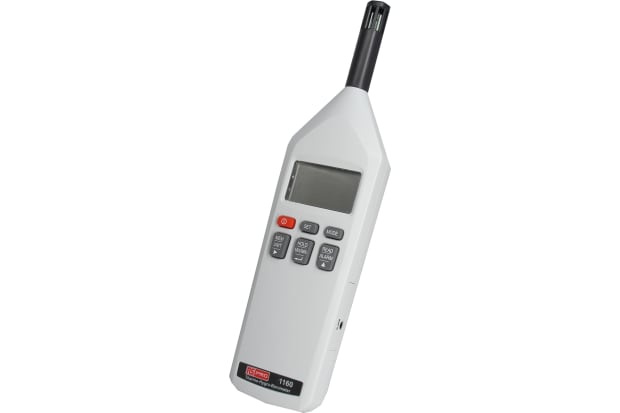- Published 20 Mar 2023
- Last Modified 29 Aug 2023
- 8 min
What is a Hygrometer?
This guide will explain how you can use, read, and calibrate a hygrometer.

Reviewed by Karl Ralph, Technical Support Engineer (October 2022)
Hygrometers are useful measuring instruments that you can use for finding out how much moisture there is in the atmosphere. The usual term for this unit of measurement is called relative humidity. By being able to determine the relative humidity in an environment you can use the information to achieve a comfortable and safe habitat for people, animals, or objects.
Some items are sensitive to humidity and the need to control the level of moisture in the air is a necessity. This is where the hygrometer becomes an essential and useful tool. Once the level of humidity is determined, you can install measures that will either decrease or increase the relative humidity of an environment.
So, what is a hygrometer? This guide will outline the various types of hygrometers available and explain how to read and calibrate them effectively.
What Does a Hygrometer Measure?

You can measure moisture content in the atmosphere or environment with a hygrometer. The measuring scale that is used is based on relative humidity which indicates how saturated with water the atmosphere in your environment is.
They are sometimes referred to as humidity meters, however, there is a difference between a hygrometer and a humidity meter. The latter is generally used for measuring moisture content in flooring or brickwork measuring how damp they are. The hygrometer is used for measuring moisture content in the air.
Uses of Hygrometers
Many industrial processes can be affected by humidity levels.
Hygrometers and humidity sensors are often used in medical applications where function can be distorted by excess or insufficient moisture. This includes incubators, sterilisers, and respiratory equipment. They are also used to monitor humidity levels when preparing various pharmaceuticals and to control humidity during the purification of chemical gases.
These instruments are also used to control humidity when producing paper and textiles, in food processing, and in film desiccation processes. They have numerous applications in agriculture, too, from dew prevention in sensitive crops to monitoring moisture content in the soil. Atmospheric moisture control is essential during the manufacture of semiconductors, and hygrometers play a critical role during wafer processing in this industry.
Domestically, these sensors are widely used to control atmospheric humidity in buildings, and they play a vital part in microwave oven cooking control.
How Does a Hygrometer Work?
There are many different types of hygrometers available and the way that they work does differ from one type to another. They all aim to show a measure of relative humidity in an environment.
Relative humidity (RH) is a percentage measurement of how much water there is present in the atmosphere. A relative humidity value of 100% is telling you that you have reached the maximum possible level of water saturation that the atmosphere can hold. A comfortable level of relative humidity at room temperature for humans is between 30 and 50%.
Modern electronic digital hygrometers often use a semiconductor sensor which measures the change in electrical resistance, electrical capacitance, or mass as it absorbs water from the atmosphere. The sensor will offer varying and proportional levels of resistance or capacitance depending on the water content that the sensor detects. Some electrical devices measure the exact temperature at which condensation occurs (the dew point).
This is then translated by the electronics in the device and will show you the value of relative humidity on a digital readout. There are also wireless hygrometers available that have a remote sensor or sensors that wirelessly communicates the humidity values to the base unit receiver.
Some of the older techniques for measuring relative humidity such as using a thermo hygrometer rely on the principle of evaporative cooling. You will find the digital hygrometer to be a more convenient and reliable method of measuring relative humidity than the glass bulb or thermo hygrometer.
What is a Thermo Hygrometer?

These instruments are sometimes referred to as glass bulb hygrometers or psychrometers. They are essentially two glass bulb thermometers mounted side by side. One of the glass bulbs on one of the thermometers is wrapped in a textile material which is constantly soaked in water. They work on the principle that heat will transfer far more efficiently from objects that are wetter (this is known as the evaporative cooling effect).
In practice, you will see a higher temperature shown on the dry bulb thermometer when compared with the temperature shown by the one where the bulb is soaked in water. As the atmosphere becomes wetter or dryer, the differential temperatures between the two thermometers will vary accordingly. The differential temperature value can be looked up from a printed table or chart which will show you the given value of relative humidity.
Sometimes a modern digital hygrometer that can measure temperature, as well as humidity, is also known as a thermo hygrometer. These should not be confused with the traditional glass bulb thermo hygrometer.
How to Read a Hygrometer
Modern electronic hygrometers can show you relative humidity values read directly from a digital readout. Some like the thermopro hygrometerswill also show a reading of temperature as well as humidity. You can also find hygrometers that can store values of minimum and maximum values of both humidity and temperature. These types are useful for monitoring an environment where values of humidity and temperature are critical and need to be maintained at certain levels.
Some digital hygrometers with the ability to read temperature values as well as humidity are known as digital thermo hygrometers. Details of how to use digital thermo hygrometer-type instruments can often be obtained from the user manuals that can be found on most of our product pages.
How to Calibrate a Hygrometer

You can calibrate some hygrometers by using a hygrometer calibration device. These humidity chambers are used in conjunction with ahygrometer capsule. The capsule releases a known and set amount of humidity into the calibration device which is attached to the hygrometer sensor. The hygrometer can then be adjusted and calibrated so that the reading matches the capsule values. If you wanted to know how to test a hygrometer for accuracy, this is the best way.
Once you have one accurately calibrated device, this will now offer a way how to set up a hygrometer that needs calibration. You can simply calibrate the second device against the first calibrated device.
History of the Hygrometer
Possibly the first humidity sensor came into the world in 1450, when a German philosopher and astronomer constructed a hair hygrometer, in a design which was subsequently drawn by Leonardo da Vinci in 1480.
The science and technology-obsessed Ferdinand de Medici II, the Grand Duke of Tuscany, built the first condensation hygrometer in 1657. Then, in 1853, the French physicist August Bravais invented a humidity sensor that he called “the whirling psychrometer”, which consisted of one wet bulb and one dry bulb thermometer mounted on an arm. The latter could be rotated through the air on an axis which acted as a handle, detecting moisture as it moved. The moisture content was calculated by means of a formula based on the different readings on the two thermometers.
The Finnish company Vaisala developed and patented the “Humicap” humidity sensor in 1973. This was a thin film of water vapour-sensitive polymer which changed its electrical capacitance in response to fluctuations in atmospheric moisture.
Since then, technological advances have yielded a wide range of different forms of humidity sensors, including:
- Saturated lithium chloride sensors – in which the salt acts as the moisture-sensing medium
- Phosphorous pentoxide electrolytic sensors – the desiccant phosphorous pentoxide converts an electrolytic process upon an applied voltage into a reading of water vapour content
- Colour-change sensors – in which a material such as cobalt chloride will change colour in relation to atmospheric water content
- Spectroscopic sensors – which rely on the infrared absorbance of water droplets in the atmosphere
- Adiabatic expansion sensors – which detect the dew point when air cools during expansion and produces fog
- Acoustic sensors – which detect alterations in the transmission of sound in air as a reflection of changes in humidity
How to Test Humidity Without Hygrometer?
A simple test of relative humidity can be done by using a clear glass filled with iced water. This is by no means an accurate form of measurement, but it will give you a rough idea of how high or low relative humidity is.
The idea is that the glass filled with ice-cold water is left to stand for a measured time. You would then check the level of condensation that has formed on the outside of the glass. If you find a lot of condensation on the glass it indicates a high level of relative humidity whereas a small amount of condensation implies a lower level of humidity.
The principle relies on the humidity level in the atmosphere condensing on the cold surface of the glass. The more water that is present in the atmosphere results in you seeing more water condensing on the glass. This method can only be used as an indication of how much humidity there is in the atmosphere as there is no actual measure of relative humidity. If you’re after a more accurate form of measurement, a hygrometer is ideal.